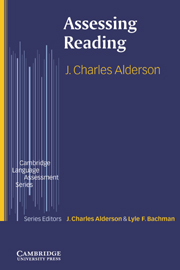Book contents
- Frontmatter
- Contents
- Series Editor's Preface
- Acknowledgements
- Abbreviations
- 1 The nature of reading
- 2 Variables that affect the nature of reading
- 3 Research into the assessment of reading
- 4 The reader: defining the construct of reading ability
- 5 A framework for test design
- 6 Tests in the real world: test purposes
- 7 Techniques for testing reading
- 8 The development of reading ability
- 9 The way forward. Assessing the interation between reader and text: processes and strategies
- Bibliography
- Index
1 - The nature of reading
Published online by Cambridge University Press: 03 May 2010
- Frontmatter
- Contents
- Series Editor's Preface
- Acknowledgements
- Abbreviations
- 1 The nature of reading
- 2 Variables that affect the nature of reading
- 3 Research into the assessment of reading
- 4 The reader: defining the construct of reading ability
- 5 A framework for test design
- 6 Tests in the real world: test purposes
- 7 Techniques for testing reading
- 8 The development of reading ability
- 9 The way forward. Assessing the interation between reader and text: processes and strategies
- Bibliography
- Index
Summary
Introduction
I am not the first person to say that an overview of the study of the nature of reading is impossible. The sheer volume of research on the topic belies any individual's ability to process, much less to synthesise, everything that is written. Similarly, the number of different theories of reading is simply overwhelming: what it is, how it is acquired and taught, how reading in a second language differs from reading in a first language, how reading relates to other cognitive and perceptual abilities, how it interfaces with memory. All these aspects of reading are important, but will probably never be brought together into a coherent and comprehensive account of what it is we do when we read. Added to this are the inevitable complications when we consider the complexities of analysing texts: since the nature of what we read must have some relation to how we read, then text analysis must be relevant to theories of reading and to research into reading. Yet the simple phrase ‘text analysis’ covers an enormous range of study within linguistics, which again no individual can hope to overview.
Any review, therefore, of ‘the nature of reading’ is bound to be somewhat pretentious, and this introductory chapter will inevitably be selective, rather than exhaustive. Yet consider the dilemma for anybody wishing to assess reading.
- Type
- Chapter
- Information
- Assessing Reading , pp. 1 - 31Publisher: Cambridge University PressPrint publication year: 2000



